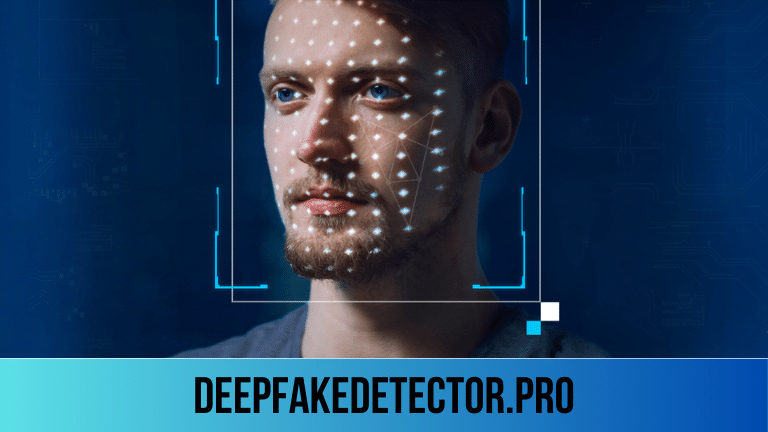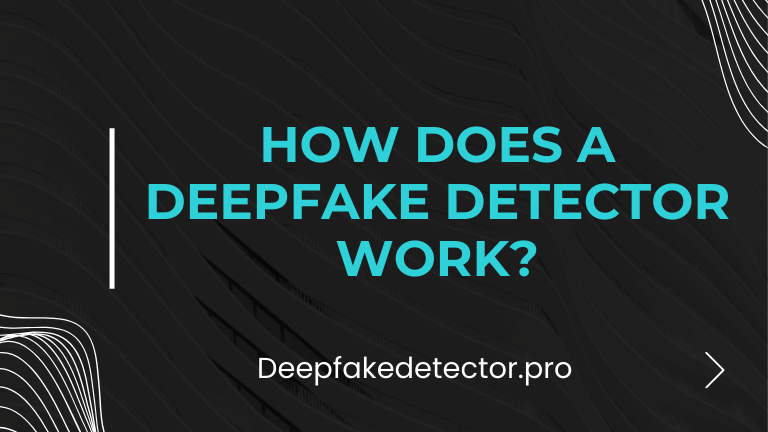How does a DeepFake Detector work? As these AI-generated videos, images, and audio recordings become increasingly difficult to distinguish from authentic media, the need for reliable deepfake detection methods has become paramount. In this comprehensive guide, we’ll explore how deepfake detectors work, delving into the underlying technologies, techniques, and challenges involved in identifying and mitigating the spread of synthetic media.
Understanding Deepfakes and Their Implications
Before delving into the mechanics of deepfake detection, it’s essential to grasp the nature of deepfakes and the potential risks they pose to society.
What Are Deepfakes?
Deepfakes are a type of synthetic media created using deep learning algorithms, particularly generative adversarial networks (GANs) and other advanced techniques. These AI models are trained on vast datasets of real images, videos, or audio recordings, enabling them to generate highly realistic synthetic content that can be difficult to distinguish from authentic media with the naked eye.
The term “deepfake” initially referred to video manipulations that swapped one person’s face onto another person’s body, but the term has since expanded to encompass a wider range of synthetic media, including:
- Face Swaps: Videos or images where one person’s face is mapped onto another person’s body, creating a realistic impersonation.
- Lip-Syncing: Videos where an individual’s mouth movements are manipulated to match different audio recordings, enabling them to appear to say things they never said.
- Voice Cloning: Audio recordings where an individual’s voice is synthesized or manipulated to mimic another person’s speech patterns and vocal characteristics.
- Full-Body Synthesis: Videos or images where an entire person or scene is generated from scratch using deep learning models, without relying on existing footage.
Potential Risks and Implications
While deepfakes can be used for creative or entertainment purposes, their ability to generate highly convincing synthetic media raises significant ethical and societal concerns:
- Disinformation and Propaganda: Deepfakes could be used to spread false or misleading information, potentially influencing public opinion, elections, or causing reputational damage to individuals or organizations.
- Identity Theft and Fraud: Synthetic media could be used to impersonate individuals for malicious purposes, such as identity theft, financial fraud, or extortion.
- Erosion of Trust: The proliferation of deepfakes could undermine trust in digital media, making it increasingly difficult to discern what is real and what is fabricated.
- Psychological and Emotional Harm: Deepfakes targeting individuals could lead to psychological distress, reputational damage, and potential legal implications.
As deepfake technology continues to advance and become more accessible, the need for reliable detection methods has become a pressing concern for individuals, organizations, and societies alike.
The Challenges of Deepfake Detection
Detecting deepfakes is a complex and evolving challenge, as the technology used to create synthetic media continues to improve and become more sophisticated. Several factors contribute to the difficulty of deepfake detection:
- Constantly Evolving Techniques: The field of deep learning and generative models is rapidly advancing, leading to the development of increasingly realistic and harder-to-detect deepfakes.
- Limited Training Data: Detecting deepfakes often relies on training machine learning models on authentic and synthetic media samples. However, obtaining large, diverse, and accurately labeled datasets can be challenging.
- Adversarial Attacks: Deepfake creators may employ adversarial techniques specifically designed to evade detection methods, continually forcing detectors to adapt and improve.
- Computational Constraints: Analyzing high-resolution videos or large media files for deepfake detection can be computationally intensive, requiring significant processing power and resources.
- Generalization Challenges: Deepfake detectors trained on specific datasets or techniques may struggle to generalize effectively to new types of deepfakes or unseen scenarios.
Despite these challenges, researchers and technology companies are actively developing various techniques and approaches to tackle the deepfake detection problem.
Traditional Deepfake Detection Methods
Before the advent of advanced deep learning techniques, traditional methods for detecting media manipulation relied on a combination of manual analysis and computational techniques. While these methods may not be as effective against state-of-the-art deepfakes, they can still provide valuable insights and serve as a foundation for more sophisticated detection approaches.
Manual Analysis and Visual Inspection
In some cases, careful visual inspection and analysis by trained experts can reveal subtle artifacts or inconsistencies that may indicate media manipulation. This approach involves closely examining various aspects of the media, such as:
- Facial Features: Inconsistencies in facial features, expressions, or lighting can sometimes reveal signs of face swapping or manipulation.
- Body Movements: Unnatural or jerky body movements may suggest that different parts of the video have been stitched together or manipulated.
- Audio and Visual Synchronization: Mismatches between lip movements and audio can indicate lip-syncing or voice cloning.
- Background Inconsistencies: Inconsistencies in the background, shadows, or reflections can reveal signs of compositing or digital manipulation.
While manual analysis can be time-consuming and subjective, it can provide valuable insights, particularly in cases where deepfake artifacts are visible to the trained eye.
Digital Forensics and Artifact Analysis
Digital forensics techniques can be employed to analyze media files for various artifacts or inconsistencies that may indicate manipulation:
- Metadata Analysis: Examining metadata embedded within media files, such as creation dates, software used, and edit histories, can provide clues about potential manipulation.
- Error Level Analysis (ELA): ELA is a computational technique that analyzes compression artifacts to detect areas of an image that may have been manipulated or spliced together.
- Noise Analysis: Different types of noise patterns or inconsistencies in noise levels across different regions of an image or video can indicate manipulation.
- Pixel Analysis: Techniques like pixel-level analysis, pixel value comparisons, and edge detection can reveal anomalies or inconsistencies that may suggest manipulation.
While these traditional methods can be useful for detecting certain types of manipulations, they may not be as effective against state-of-the-art deepfakes, which can often bypass or conceal these artifacts.
Deep Learning-Based Deepfake Detection
With the increasing sophistication of deepfakes, researchers and technology companies have turned to deep learning and artificial intelligence techniques to develop more robust and effective detection methods. These approaches leverage the power of machine learning to analyze and identify patterns and artifacts that may be imperceptible to human analysts.
Convolutional Neural Networks (CNNs)
Convolutional Neural Networks (CNNs) are a type of deep learning architecture particularly well-suited for analyzing and processing visual data, such as images and videos. CNNs can be trained on large datasets of authentic and deepfake media to learn the subtle patterns and features that distinguish genuine content from synthetic media.
Several CNN-based approaches have been proposed for deepfake detection:
- Transfer Learning: Existing pre-trained CNN models, originally developed for tasks like image classification or object detection, can be fine-tuned on deepfake datasets to adapt them for the detection task.
- Specialized CNN Architectures: Researchers have designed specialized CNN architectures specifically tailored for deepfake detection, incorporating features like attention mechanisms, multi-task learning, or ensemble models.
- Temporal CNN Models: For video analysis, temporal CNNs (such as 3D CNNs or recurrent models) can capture and analyze the temporal dynamics and inconsistencies that may be present in deepfake videos.
CNNs can be trained to detect various types of deepfake artifacts, such as inconsistent eye blinking, unnatural facial expressions, or discrepancies in lighting and shadows.
Generative Adversarial Networks (GANs)
Interestingly, the same generative adversarial network (GAN) architecture used to create deepfakes can also be employed for detection purposes. In a GAN setup for deepfake detection, the generator tries to create synthetic media that can fool the discriminator, while the discriminator tries to accurately classify media as real or fake.
By training the discriminator on a large dataset of authentic and deepfake media, it can learn to identify the subtle differences and patterns that distinguish real from synthetic content. This adversarial training process can lead to highly effective deepfake detectors capable of identifying even the most sophisticated deepfakes.

FAQs
How do DeepFake detectors identify manipulated media?
DeepFake detectors use advanced algorithms and machine learning techniques to analyze media for signs of tampering. They look for inconsistencies in facial movements, lighting, and shadows, as well as irregularities in audio and image quality. By comparing these elements to a database of genuine media, they can identify potential DeepFakes.
What technologies are used in DeepFake detection?
DeepFake detectors employ a variety of technologies, including deep learning, neural networks, computer vision, and digital forensics. These technologies help in detecting subtle artifacts and patterns that are often introduced during the creation of DeepFakes.
How does a neural network help in detecting DeepFakes?
Neural networks are trained on vast datasets of both real and manipulated media. During this training, they learn to recognize features and patterns associated with DeepFakes. When presented with new media, the neural network can compare it to its learned patterns to determine if it has been altered.
Can DeepFake detectors analyze both video and audio content?
Yes, modern DeepFake detectors can analyze both video and audio content. For videos, they assess visual elements like facial expressions and movements, while for audio, they examine speech patterns, tone, and background noise. Combining these analyses enhances the accuracy of the detection process.
How reliable are DeepFake detectors in identifying sophisticated DeepFakes?
The reliability of DeepFake detectors has improved significantly, but highly sophisticated DeepFakes can still pose a challenge. Continuous advancements in machine learning and the constant updating of detection algorithms help maintain and enhance their effectiveness. However, no detector is foolproof, and there is always a margin for error.

